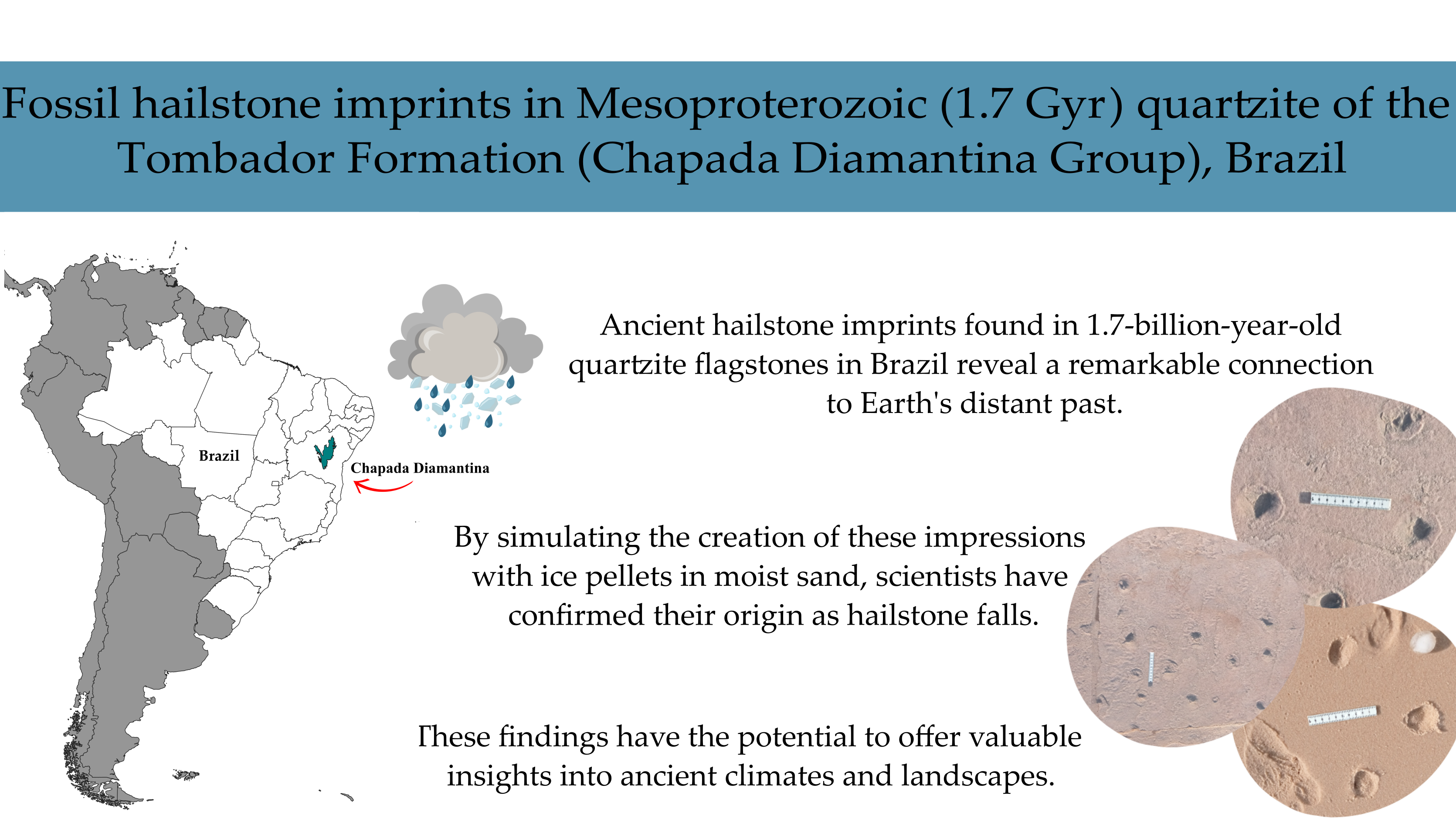Fossil hailstone imprints in Mesoproterozoic (1.7 Gyr) quartzite of the Tombador Formation (Chapada Diamantina Group), Brazil
DOI:
https://doi.org/10.14295/bjs.v3i2.468Keywords:
hailstone impressions, raindrop impressions, hailAbstract
Fossil pockmarks, 2.5-4 cm in diameter, 3-8 mm deep, with raised, asymmetrical borders are preserved in Mesoproterozoic quartzite representing fluvial and eolic lithofacies of the Tombador Formation (Chapada Diamantina Group) deposited 1.7 billion years ago in what is now northeastern Brazil. Indentations created by projecting 2-4 cm diameter ice pellets into moist beach sand were of the same type - with raised, asymmetrical borders and equivalent diameters and depths – strongly supporting the hypothesis that the fossil features represent impressions of paleohailstone impacts. These well-defined and well-preserved paleohailstone impressions represent the oldest known features of their type in the world, and the first records from South America.
References
Álvaro, J. J. (2012). Colour banding in a latest Neoproterozoic–Cambrian microbially variegated sabkha of the Taoudeni Basin, Adrar of Mauritania: Palaeogeography, Palaeoclimatology, Palaeoecology v. 367–368, p. 209–218. https://doi.org/10.1016/j.palaeo.2011.06.019. DOI: https://doi.org/10.1016/j.palaeo.2011.06.019
Brazil (1990). Programa Levantamento Geológicos Básicos do Brasil – Utinga (Folha SD.24-V-A-II) Estado da Bahia. Departamento Nacional da Produção Mineral - DNPM
Boggs. J. M. (2006). Principles of Sedimentology and stratigraphy, 4th Edition. Ed. Prentice Hall, Upper Saddle River, New Jersey, USA
Kent, L. E. (1938). Probable Fossil Hail Impressions in Natal Coal Measures (Middle Ecca Series). Nature, 3575, p. 835 DOI: https://doi.org/10.1038/141835b0
Long, I. F. (1963). Fossil Hail Prints. Weather, 18(4), 115. https://doi.org/10.1002/j.1477-8696.1963.tb01983.x DOI: https://doi.org/10.1002/j.1477-8696.1963.tb01983.x
Lyell, C. (1851). Rain-marks of the Recent Triassic, and Carboniferous Periods. Quart. J. Geol. Soc. Lond. 7, 238-247. DOI: https://doi.org/10.1144/GSL.JGS.1851.007.01-02.40
Metz, R. (1981). Why not Raindrop Impressions. J. Sedimentary Petrology, 51(1):0265-0268
https://doi.org/10.1306/212F7C66-2B24-11D7-8648000102C1865D DOI: https://doi.org/10.1306/212F7C66-2B24-11D7-8648000102C1865D
Niedzwiedzki, G., Piotr, S., Narkiewicz, K., Narkiewicz, M., & Ahlberg, P. E. (2010). Tetrapod trackways from the early Middle Devonian period of Poland. Nature, 463, 43-48. https://doi.org/doi:10.1038/nature08623 DOI: https://doi.org/10.1038/nature08623
Remin, Z., Krogulec, T., Drela, T., and Surowski, M. (2014). The recognition of hailstone impressions in clay-rich sediment: experimental results and relation to the neoproterozoic case. J. of Sedimentary Research, 2014, v. 84, 543–551. https://doi.org/doi:10.2110/jsr.2014.46 DOI: https://doi.org/10.2110/jsr.2014.46

Downloads
Published
How to Cite
Issue
Section
License
Copyright (c) 2023 Roy Richard Funch

This work is licensed under a Creative Commons Attribution 4.0 International License.
Authors who publish with this journal agree to the following terms:
1) Authors retain copyright and grant the journal right of first publication with the work simultaneously licensed under a Creative Commons Attribution License that allows others to share the work with an acknowledgement of the work's authorship and initial publication in this journal.
2) Authors are able to enter into separate, additional contractual arrangements for the non-exclusive distribution of the journal's published version of the work (e.g., post it to an institutional repository or publish it in a book), with an acknowledgement of its initial publication in this journal.
3) Authors are permitted and encouraged to post their work online (e.g., in institutional repositories or on their website) prior to and during the submission process, as it can lead to productive exchanges, as well as earlier and greater citation of published work.



